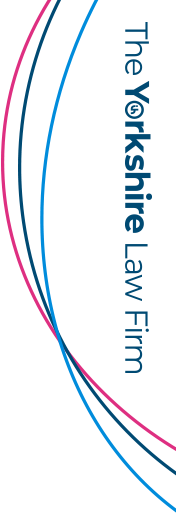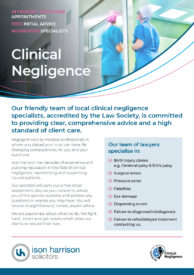Erb’s Palsy Solicitors
Erb’s Palsy is also known as brachial plexus paralysis, and it is a traumatic birth injury that can leave a baby’s arm severely paralysed. The brachial plexus is most often injured when it is subjected to a pulling force, and it is generally associated with larger babies that get stuck during the birthing process, (Shoulder Dystocia). If excessive force or force applied in the wrong direction, is used before the baby is dislodged, the brachial plexus may suffer nerve damage ranging from bruising to tearing. Brachial plexus nerves are crucial to the strength, movement and feeling in the arms. There are 5 primary nerves that run from the spinal column in the neck, across the shoulders and down the arms to the fingers. If any one or all five of these nerves are damaged, the Erb’s Palsy can range from partial to complete paralysis, also known as a flail arm.
Swift diagnosis and treatment is important. Children who suffer from Erb’s Palsy usually have to undergo hours of physiotherapy daily and those with a severe injury can need several operations to restore some function to their arm. The injury for some children will have been so severe that they will live with some impairment for the rest of their lives.
Clinical Negligence Claims
Sadly, despite the excellent standards of today’s medical professionals, many of the cases of Erb’s Palsy that still occur could be prevented.
Some cases involve negligence even before your baby is born. One of the first things that needs to be considered is the mode of delivery, vaginal or caesarean section. Both have risks and benefits, but these delivery options should be discussed and a decision should be made with your clinician to decide what you want to do. Providing informed consent to the mode of delivery is extremely important, but is often overlooked because “doctor knows best”.
Mums who are at increased risk of experiencing a shoulder dystocia include:
- A previous delivery complicated by shoulder dystocia;
- A previous Macrosomic baby, (more than 4.5kg);
- Having diabetes, type 1, 2 or gestational diabetes;
- A BMI > 30;
- A baby which is recognised on the antenatal scans as being big;
- Oxytocin to induce labour;
- A long 1st or 2nd stage of labour;
- An instrumental delivery, (i.e. Ventouse and/or forceps).
When Shoulder Dystocia is encountered, it is a medical emergency because the flow of oxygenated blood to your baby is impeded and if this continues for too long it can result in brain injury and in the worse circumstances, death. It is important that the clinician can recognise the problem of shoulder dystocia so that they can then act to overcome it without injuring you or your baby.
Once shoulder Dystocia is recognised a call for help should be made immediately. External manoeuvres should then be used to free the impacted shoulder which has become stuck.
The McRoberts Position
McRoberts is the first position that should be used. Ideally with a Midwife on each leg. It involves sharply flexing the legs upon the maternal abdomen. By doing this, the symphysis pubis is rotated and the sacrum is straightened.
Suprapubic Pressure
The second external maneuver is suprapubic pressure. This is the attempt to manually dislodge the shoulder at Mum’s front from behind the symphysis pubis. It is performed by making a fist, placing it just above the maternal pubic bone, and pushing the fetal shoulder in one direction or the other. Pushing the baby’s shoulder to one side or the other from above can often change its position to the oblique which will allow its delivery.
If McRoberts and suprapubic pressure are applied correctly this will overcome the impaction in the vast majority of cases and avoid injury to the Brachial plexus. Unfortunately in some cases excessive pulling on the head is used to either deliver the baby or is applied when the baby is still stuck and the shoulder dystocia has not been overcome, which results in an injury that should have been avoided.
If external manoeuvres are unsuccessful then internal manoeuvres can be attempted to try and manipulate the position of the baby to overcome the impaction of the shoulder that is stuck. This will involve assessment and probably an episiotomy to help increase the space that the clinical has to work with. Depending on the clinician’s training, skill and expertise this should also overcome the shoulder dystocia and allow a safe delivery.
If your child is unfortunate enough to sustain an Erb’s Palsy injury then it is important to ensure that your child is followed up and not lost in the system. Without appropriate review and treatment problems can be created which can become difficult to undo and treat.
At Ison Harrison we understand that it can be extremely difficult to learn that your child has suffered an injury and to deal with the emotional and financial strain of raising a child that requires additional care and aids to help them live independently with what can be a permanent disability. We have represented many Erb’s children and their families and secured significant settlements which enable them to go on to live their lives to the full with the security of knowing that they have the damages they will need for life to make up for the things they cannot do, need help with or need costly equipment to allow them to maintain their independence.
Our Clinical Negligence Team
Our clinical negligence team is headed up by James Thompson, a Partner of the firm and an experienced Solicitor who is respected throughout the legal industry. James is responsible for a specialist team of highly-qualified and experienced clinical negligence professionals. Our staff take great pride in adopting a client-focused and sensitive approach.
Erb’s children will often qualify for legal aid and we are one of the few firms in the country still authorised to undertake legal aid work in clinical negligence claims.
We work with the Erb’s Palsy Group, a national charity which offers support and information to families affected by Erb’s Palsy. James Thompson is the only Solicitor in the North that the Erb’s Palsy Group recommend. Erb’s cases can be extremely complex and they should not be attempted by inexperienced lawyers. It is therefore vitally important when considering whether to pursue a claim you consult a specialist lawyer with the skill, knowledge and expertise to ensure you or your child’s case is investigated, pursued and progressed to the right conclusion.
James Thompson is also a Director and Trustee of the Little Hiccups Charity, a parent-led support group for families with children with disabilities.
james.thompson@isonharrison.co.uk
If for any reason James is not available when you call, you can speak with a member of his team and they will arrange a mutually convenient time for him to speak with you.
FAQs
The brachial plexus is most often injured when it is subjected to a pulling force, and it is generally associated with larger babies that get stuck during labour (Shoulder Dystocia). If excessive force or force applied in the wrong direction, is used before the baby is dislodged, the brachial plexus may suffer nerve damage ranging from bruising to tearing. Brachial plexus nerves are crucial to the strength, movement and feeling in the arms. There are 5 primary nerves that run from the spinal column in the neck, across the shoulders and down the arms to the fingers. If any one or all five of these nerves are damaged, the Erb’s Palsy can range from partial to complete paralysis, also known as a flail arm.
Children who suffer from Erb’s Palsy usually have to undergo hours of physiotherapy daily and those with a severe injury can need several operations to restore some function to their arm. The injury for some children will have been so severe that they will live with some impairment for the rest of their lives.
Sadly, despite the excellent standards of today’s medical professionals, many of the cases of Erb’s Palsy that still occur could be prevented. Some cases involve negligence even before your baby is born. One of the first things that need to be considered is the mode of delivery, vaginal or caesarean section. Both have risks and benefits, but these delivery options should be discussed and a decision should be made with your clinician to decide what you want to do. Providing informed consent to the mode of delivery is extremely important, but is often overlooked because “doctor knows best”.
Mums who are at increased risk of experiencing a shoulder dystocia include:
– A previous delivery complicated by shoulder dystocia;
– A previous large (macrosomic) baby, (more than 4.5kg);
– Having diabetes, type 1, 2 or gestational diabetes;
– A BMI > 30;
– A baby which is recognised on the antenatal scans as being big;
– Oxytocin to induce labour;
– A long 1st or 2nd stage of labour;
– An instrumental delivery, (i.e. Ventouse and/or forceps).
When Shoulder Dystocia is encountered, it is a medical emergency because the flow of oxygenated blood to your baby is impeded and if this continues for too long it can result in brain injury and in the worse circumstances, death. It is important that the clinician can recognise the problem of shoulder dystocia so that they can then act to overcome it without injuring you or your baby.
Once shoulder Dystocia is recognised a call for help should be made immediately. External manoeuvres should then be used to free the impacted shoulder which has become stuck.
McRoberts is the first position that should be used. Ideally with a Midwife on each leg. It involves sharply flexing the legs upon the maternal abdomen. By doing this, the symphysis pubis is rotated and the sacrum is straightened.
The second external manoeuvre is suprapubic pressure. This is the attempt to manually dislodge the shoulder at Mum’s front from behind the symphysis pubis. It is performed by making a fist, placing it just above the maternal pubic bone, and pushing the fetal shoulder in one direction or the other. Pushing the baby’s shoulder to one side or the other from above can often change its position to the oblique which will allow its delivery.
If McRoberts and suprapubic pressure are applied correctly this will overcome the impaction in the vast majority of cases and avoid injury to the Brachial plexus. Unfortunately in some cases excessive pulling on the head is used to either deliver the baby or is applied when the baby is still stuck and the shoulder dystocia has not been overcome, which results in an injury that should have been avoided.
If external manoeuvres are unsuccessful then internal manoeuvres can be attempted to try and manipulate the position of the baby to overcome the impaction of the shoulder that is stuck. This will involve assessment and probably an episiotomy to help increase the space that the clinical has to work with. Depending on the clinician’s training, skill and expertise this should also overcome the shoulder dystocia and allow a safe delivery.
If your child has sustained an Erb’s Palsy injury then it is important to ensure that your child is followed up and not lost in the system. Without appropriate review and treatment problems can be created which can become difficult to undo and treat.
We understand that it can be extremely difficult to learn that your child has suffered an injury and to deal with the emotional and financial strain of raising a child that requires additional care and aids to help them live independently with what can be a permanent disability.
Erb’s cases can be extremely complex and they should not be attempted by inexperienced lawyers. It is therefore vitally important when considering whether to pursue a claim you consult a specialist lawyer with the skill, knowledge and expertise to ensure you or your child’s case is investigated, pursued and progressed to the right conclusion.






































